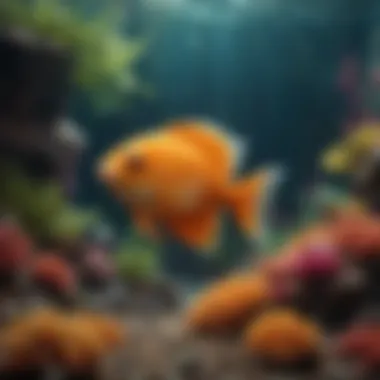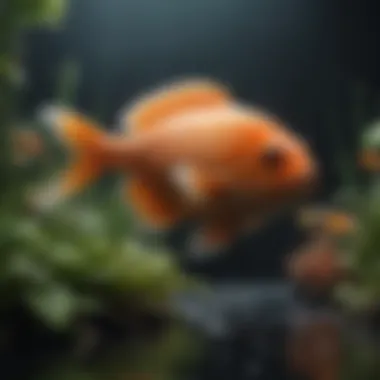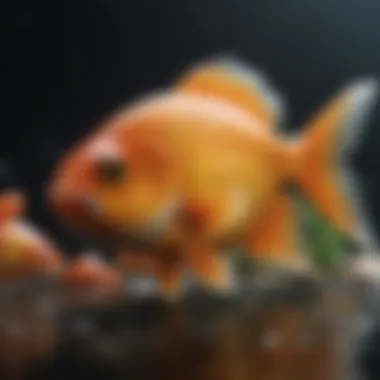Understanding Tang Fish Food: A Deep Dive into Nutrition


Intro
Tang fish, often known as surgeonfish, are not only vibrant and colorful but also showcase a diverse range of dietary needs that are often misunderstood. The health and vitality of these fish heavily rely on the quality of food they consume. Understanding their dietary requirements is essential for aquarium enthusiasts seeking to maintain a thriving aquatic environment.
In this article, we will delve into the intricacies of tang fish food, examining various types of food, their nutritional values, feeding habits, and how these factors collectively influence the overall well-being of tang fish. Whether you are a novice or have years of experience in fishkeeping, our insights aim to help you foster informed feeding practices that support your fish's health.
Fascinating Facts About the Animal
Unique Characteristics
Tang fish display unique anatomical features, including the distinct spines on either side of their bodies. These spines serve as a form of defense against predators. Their striking colors range from deep blues to bright yellows and oranges, allowing them to blend into their coral reef habitats. Such vivid colors also play a role in social interactions and mating rituals.
Extraordinary Abilities
Tang fish exhibit remarkable agility in the water. They are capable of quick bursts of speed, which aid in evading predators and navigating through complex reef environments. Their ability to school also enhances their survival, as they can confuse predators with their synchronized movements.
Behavior and Habitat
Natural Habitats
In the wild, tang fish predominantly inhabit coral reefs in warm, tropical oceans. Regions such as the Indo-Pacific and Caribbean are home to numerous species. While they thrive in shallow waters, they often swim toward deeper areas during the day to escape high temperatures and intense sunlight.
Social Structures
Tang fish are known to be social creatures. They often form schools that provide safety and companionship. Within these schools, social hierarchies can establish, influencing feeding and territorial behaviors. Understanding these social dynamics can help aquarium owners create a more suitable environment.
Recent Scientific Discoveries
Latest Research Findings
Recent studies have revealed the critical link between diet and the immune system of tang fish. Research indicates that a diet rich in algae and vitamins can enhance immune response, making tang fish more resistant to disease.
Breakthroughs in Animal Biology
Scientists are also exploring the gut microbiome of tang fish. Preliminary findings suggest that a diverse microbiota plays a role in nutrient absorption and overall health. This area of study is still developing but holds promise for improving fish diets.
Cultural Significance
Animals in Folklore
Tang fish have captured the fascination of various cultures, often symbolizing beauty and resilience in aquatic ecosystems. In some regions, they hold traditional significance as symbols of prosperity.
Influence on Art and Literature
The striking appearance of tang fish has inspired numerous artistic representations. Their vivid colors and shapes are frequently depicted in marine-themed artworks, reflecting humanity's enduring connection to the ocean.
Foreword to Tang Fish
The introduction of tang fish to the article serves a vital role in establishing a foundational understanding of these fascinating aquatic creatures. Tang fish, also known as surgeonfish, are not just visually appealing to aquarium enthusiasts; they are intricate beings with specific dietary needs. Understanding their characteristics and habitat is crucial for anyone interested in maintaining their health and well-being. This section will discuss several key elements of tang fish, including their unique traits and natural environments, which will provide insights into their feeding requirements.
Characteristics of Tang Fish
Tang fish are distinguished by their vibrant colors and unique body shapes, which often resemble teardrops. They generally have a compressed body, allowing swift movements in water. Most tang species possess sharp spines near their tails, which can be used for defense. These spines are characteristic of the Acanthuridae family, from which they belong.
Their sizes can vary; some can grow larger than a foot while others may remain considerably smaller. The most well-known species, like the blue tang, and the yellow tang, are popularly kept in aquariums. Each species has its own color patterns, further emphasizing their beauty.
Tang fish are social creatures, often found in schools. They have specific behavioral traits, like grazing on algae in their natural habitats. This unique feeding behavior makes it essential that aquarists understand their needs for a proper diet, which we'll delve into later in this article.
Habitat and Distribution
Tang fish inhabit diverse marine environments, typically found in coral reefs and lagoons across the tropical and subtropical oceans of the world. They are predominantly present in the Indo-Pacific region, thriving in shallow waters where there's abundant vegetation and algae.


The coral reefs provide not just food but also protection from predators. They display a preference for areas with plenty of hiding spots, like rocky crevices among coral formations. Understanding their distribution is essential for anyone looking to replicate their natural environment in an aquarium.
Notably, each species of tang fish has its specific habitat ranges. For example, the blue tang is largely found in the coral reefs of the Caribbean and Pacific Oceans, while the yellow tang is native to the coral habitats of Hawaii. This awareness of habitat can influence the conditions and requirements for their care in captivity.
Understanding the habitat and characteristics of tang fish is key in providing them with an appropriate diet that mirrors their natural feeding habits, ensuring better health and longevity.
Nutritional Requirements of Tang Fish
Nutritional requirements play a vital role in the overall health and vitality of tang fish. These fish need a balanced diet that includes all essential nutrients to thrive in both their natural habitat and aquariums. A proper diet not only promotes growth but also supports immune function, enhances color, and improves reproductive health. Neglecting these needs can lead to various health issues, making it crucial for aquarists to understand and provide for these requirements.
Essential Nutrients
Tang fish require a variety of essential nutrients for optimal health. Here are the main categories and their significance:
- Proteins: Proteins are critical for growth and tissue repair. They help build muscle and support metabolic functions. Quality fish foods designed for tang fish often have proteins sourced from marine ingredients, which is more beneficial compared to low-quality alternatives.
- Lipids: Fatty acids, particularly omega-3 and omega-6, are important for energy. These lipids also contribute to healthy cell membranes and hormonal balance. Highly unsaturated fatty acids can be especially effective in improving fish health and coloration.
- Carbohydrates: While not an essential nutrient, carbohydrates act as an energy source. They help maintain gut health and can contribute to the overall well-being of tang fish, especially when supplied in moderate amounts.
- Vitamins: Vitamins like A, C, and E serve various functions in tang fish health, including immune response and antioxidant protection. Supplementing fish food with these vitamins can help prevent deficiencies that may arise in captivity.
- Minerals: Essential minerals such as calcium, phosphorus, and trace elements are needed for various bodily functions. For example, calcium plays a crucial part in bone health and growth, while phosphorus is vital for energy transfer within cells.
These nutrients must be balanced appropriately. Overemphasis on one category can lead to deficiencies in others. Therefore, a well-formulated diet that meets all nutritional needs is of utmost importance.
Importance of Dietary Fiber
Dietary fiber is often overlooked in the diets of tang fish. However, it plays a significant role in promoting healthy digestion and preventing various health issues. Here are key points related to the importance of dietary fiber:
- Gut Health: Fiber aids in maintaining gut health by supporting the growth of beneficial bacteria. A healthy gut microbiome improves nutrient absorption and contributes to overall fish health.
- Preventing Constipation: Fish, like tang fish, may experience digestive problems if their diet lacks fiber. Proper fiber content helps facilitate smooth bowel movements and prevents constipation, which can lead to more serious health concerns.
- Energy Regulation: Fiber can help regulate energy levels. It slowly releases energy, allowing tang fish to sustain their activity without sudden spikes in energy that could arise from high carbohydrate diets.
- Detoxification: Fiber helps in the natural detoxification processes of tang fish. It can bind to certain toxins in the digestive tract, assisting in their elimination from the body and thereby improving overall health.
Incorporating fiber-rich food sources, such as certain algae and plant-based ingredients, is crucial for providing a balanced diet that enhances gut health and prevents deficiencies.
A balanced diet ensures that tang fish can exhibit their natural behaviors and colors, crucial for both their well-being and the aesthetics of any aquarium.
Understanding these nutritional requirements allows aquarists to create an optimal diet for their tang fish. Emphasizing variety and balanced nutrition leads to healthier fish and a more vibrant aquarium environment.
Types of Tang Fish Food
Tang fish, known for their vibrant colors and unique swimming patterns, require a well-rounded diet to ensure optimal health. Understanding the different types of food available is crucial for any tang fish owner. Each food type offers distinct benefits and requires consideration of factors such as digestibility, nutritional value, and convenience.
Flake Foods
Flake foods are a popular choice among aquarium enthusiasts for feeding tang fish. They tend to be easy to use and store, making them a convenient option. These flakes often contain a mixture of fish meal, spirulina, and vitamins.
The primary advantage of flake foods is their ability to float on the water surface for some time, allowing fish to feed at their own pace. However, it is essential to choose high-quality flake food that is specifically formulated for tang fish rather than generic formulations.
Some common ingredients to look for include:
- Algae, especially spirulina, which is critical for the nutrient needs of tang fish.
- High protein content, supporting growth and health.
- Added vitamins and minerals to enhance the overall dietary value.
Pelleted Foods
Pelleted foods come in various sizes, catering to different tang fish species. These pellets provide a balanced diet with essential nutrients. The shape and texture promote healthy eating habits. Unlike flakes, pellets sink, which encourages tang fish to forage more naturally. This can stimulate their instincts and provide mental enrichment.
When choosing pelleted food, look for:
- Slow-sinking pellets that remain intact in water to prevent waste.
- Quality protein sources, which help in recovery during periods of stress or illness.
- Ingredients that improve digestion, as tang fish can be susceptible to digestive issues.
Frozen and Freeze-Dried Options
Frozen and freeze-dried food options are excellent for providing tang fish with a diverse menu. These foods retain a high nutritional value since they are minimally processed. Options include brine shrimp, bloodworms, and various types of algae.
Feeding frozen food can replicate the natural conditions in which tang fish thrive. It's beneficial for their growth and overall health. When considering frozen or freeze-dried foods, keep in mind:
- The importance of thawing frozen food properly to avoid shock for the fish.
- Shelf life and storage needs to ensure freshness and nutritional content.
- Regular rotation of food types to provide variety in the diet.
Live Foods
Live food, such as small shrimp or copepods, presents an enticing option for tang fish. This form of feeding mimics their natural hunting behavior. While not usually the primary food source, incorporating live food can enhance texture, flavor, and nutrition in their diet.


Live foods can have significant benefits:
- They can help to stimulate appetite, particularly in sick or stressed fish.
- Natural movement draws out predatory instincts, offering both physical and mental stimulation.
- Potential nutrition gain, as live food is often rich in fatty acids, which are vital for vibrant coloration and health.
A few considerations are:
- The potential risk of introducing pathogens if the live food is not sourced from reputable suppliers.
- The balance of live food intake with regular feeding to avoid nutritional deficiencies.
Adequate knowledge on types of tang fish food is essential for their well-being and longevity in captivity.
Feeding Practices for Tang Fish
Feeding practices play a crucial role in ensuring the health and vitality of tang fish. Proper feeding habits contribute to optimal growth, improved coloration, and a balanced ecosystem within aquariums. Understanding these practices requires attention to specific elements, such as feeding frequency, portion control, and the variety in diet. These aspects not only enhance the well-being of tang fish but also prevent common dietary issues that can arise from improper feeding methods.
Feeding Frequency
Feeding frequency is vital in determining how well tang fish thrive. Typically, these fish should be fed two to three times a day. This schedule aligns with their natural feeding habits, where they graze continuously. Overfeeding is often a concern, as it can lead to poor water quality and health issues. Moreover, younger fish generally require more frequent feedings compared to adult tang fish due to their higher growth rate.
A consistent feeding routine fosters familiarity, which can reduce stress levels in fish. For those who worry about overfeeding, observing the fish during feeding times can be an effective measure. If fish consistently seem uninterested after a few moments, it is better to reduce the portion size or frequency. This will help maintain water quality and ensure that food is fully consumed.
Portion Control
Portion control is a crucial factor in the feeding process of tang fish. Providing the right amount of food not only supports healthy growth but also minimizes waste accumulation in the tank. A common rule of thumb is to feed an amount that can be consumed within two to three minutes. This applies to all food types, whether it be flakes, pellets, or frozen options.
It is wise to monitor the fish closely during and after feeding sessions. Adjustments can be made based on how quickly they consume the offered food. Sometimes, using a feeding ring can help contain food, ensuring that it stays within reach and prevents fish from overeating. Thus, maintaining proper portion control encourages a balanced diet and healthy aquatic environment.
Variety in Diet
Introducing variety into the diet of tang fish is essential for their health. Just like many other species, these fish benefit from a diverse range of nutrients found in different food sources. Offering a mix of flakes, pellets, fresh vegetables, and occasional live food can significantly enhance their nutritional profile. This practice mimics their natural diet, which includes algae and other marine plant life.
Moreover, varying the diet can prevent boredom and encourage activity, which is beneficial for their overall development. Each food type offers unique advantages; for instance, algae-based foods provide beneficial fiber that supports gut health. Thus, ensuring a varying diet not only meets the nutritional requirements but also promotes overall animal well-being.
Fish thrive on small changes. A varied diet can lead to striking results in color and overall vitality.
In summary, feeding practices for tang fish are foundational aspects of their care. Keeping a consistent feeding schedule, controlling portions, and providing a variety of food sources are all critical to their health and happiness. Following these guidelines will yield positive outcomes, which is beneficial for both the fish and their aquatic environments.
Impact of Diet on Tang Fish Health
The relationship between diet and health in tang fish is pivotal. These fish, known for their vivid colors and unique shapes, have specific nutritional needs essential for their well-being. Understanding how diet impacts their overall health can lead to better care practices for both aquarists and professionals in marine biology.
Common Nutritional Deficiencies
Nutritional deficiencies in tang fish can result in a range of health issues, affecting their growth, immunity, and coloration. Some common deficiencies include the lack of vitamins such as A, C, and E, as well as essential fatty acids.
- Vitamin A deficiency can lead to poor vision and impaired immune function.
- Vitamin C is critical for collagen synthesis; a lack of it results in weakened skin and increased susceptibility to diseases.
- Vitamin E deficiency may affect reproduction and growth.
- Omega-3 and omega-6 fatty acids are necessary for maintaining energy levels and overall health.
Recognizing the signs of these deficiencies is vital. Symptoms may include fading colors, lethargy, or unusual swimming patterns. By improving the dietary intake with a more balanced feed, fishkeepers can enhance the health of their tang fish and reduce the risk of these common issues.
Effects of Overfeeding
Overfeeding tang fish is a common mistake among aquarists. While it may seem harmless, excessive feeding can lead to serious health complications. Overfeeding can cause several issues:
- Increased waste production, leading to toxic water conditions.
- Obesity, which can result in swim bladder problems and impaired swimming ability.
- Nutrient imbalance; too much of certain foods may displace the necessary nutrients, causing deficiencies.
Fishkeeper must monitor the feeding practices closely, ensuring that food is consumed within a few minutes. By practicing portion control, fishkeepers can avoid these negative outcomes and maintain a healthier environment for their tang fish.
Proper diet management is crucial; overfeeding can do more harm than good.
In summary, understanding the impact of diet on tang fish health is essential for successful aquarium management. Regular evaluation of both dietary habits and health symptoms can foster a thriving aquatic ecosystem.
Homemade vs.


Commercial Tang Fish Food
The choice between homemade and commercial tang fish food is pivotal for aquarists aiming to optimize the health and vitality of their fish. Each option carries its own merits and challenges, influencing the selection process for enthusiasts and experts alike. Understanding these distinctions can enhance feeding strategies, leading to better outcomes for tang fish. Below, we explore the pros and cons of homemade food and the benefits commercial products provide.
Pros and Cons of Homemade Food
Homemade tang fish food allows aquarists to tailor diets to the specific needs of their fish, focusing on freshness and ingredient quality. Many owners feel a sense of satisfaction when crafting their mixes, believing it fosters a deeper connection to their pets.
Pros:
- Ingredient Control: Individuals can choose high-quality ingredients, ensuring optimal nutrition without harmful additives.
- Customization: Owners can create diets specific to individual tang fish preferences, focusing on preferences or dietary restrictions.
- Cost-Effectiveness: In some cases, making food at home can be more economical than purchasing branded products frequently.
Cons:
- Nutritional Balance: It can be challenging to achieve a complete and balanced diet. Omitting certain vitamins or minerals can lead to deficiencies.
- Time-Consuming: Preparing food from scratch requires significant time and effort, which may not be feasible for all owners.
- Storage Issues: Homemade food typically has a shorter shelf life compared to commercial options and may require precise storage methods to prevent spoilage.
Benefits of Commercial Products
Commercial tang fish food is designed to meet the dietary requirements of these fish. Specifically formulated products often include a favorable balance of nutrients, providing convenience as well.
Benefits:
- Convenience: Ready-to-feed options eliminate the need for preparation and can save time for busy aquarists.
- Nutritional Assurance: These products are balanced to deliver necessary vitamins and minerals, reducing the risk of deficiencies.
- Research-Backed Formulations: Many commercial foods, such as brands like Hikari or Omega One, undergo research and testing to ensure they meet the dietary needs of tang fish.
Important Note: While commercial foods can offer substantial benefits, not all products are created equal. It is essential to review ingredients and nutritional content closely to select optimal formulas for specific tang species.
Innovations in Tang Fish Feeding
Innovations in tang fish feeding are significant in enhancing the nutrition and well-being of these aquatic species. As research advances, new methods and products are developed to meet the evolving needs of aquarists and the fish themselves. Understanding these innovations is crucial for anyone interested in tang fish care, from veterinarians to aspiring hobbyists. These advancements can lead to healthier fish, improved growth rates, and overall better aquarium environments.
Technological Advancements
Technological advancements in fish feeding have opened doors to new possibilities. One notable development is the creation of smart feeders. These devices allow for precise control of feeding times and amounts, reducing waste and ensuring that fish receive the right nutrients at the right intervals. Smart feeders can be programmed, enabling owners to maintain consistency in feeding even during holidays or trips.
Another key advancement is the use of specialized formulations tailored to the specific dietary needs of tang fish. Science-based diets that incorporate various marine ingredients are gaining popularity. These formulations often include high-quality sources of protein and essential fatty acids that mimic the natural diet of tang fish. Additionally, some products are infused with probiotics, enhancing gut health and digestion.
Moreover, pelletizing technology has evolved, allowing for the production of highly digestible and slow-sinking pellets. This ensures that fish have ample opportunity to consume their food while minimizing the risk of overfeeding. The water stability of these pellets is also improved, which aids in maintaining water quality and clarity.
Future Trends in Aquaculture
Looking forward, the future trends in aquaculture may shape the way we feed tang fish. Sustainable sourcing of ingredients is gaining traction. The aquaculture industry faces scrutiny about its environmental impact, leading to the exploration of alternative protein sources like insects and plant-based options. These alternatives not only reduce dependence on wild fish stocks but also improve the ecological footprint of fish farming.
Another promising trend is the integration of precision aquaculture techniques. This involves the use of data analytics and monitoring technologies. These systems can assess water quality, fish behavior, and feeding patterns, helping aquarists adapt their feeding strategies and create optimal conditions for tang fish. By using data, fish keepers can make informed decisions, potentially leading to healthier aquatic environments.
Understanding feeding innovations is key to promoting the health of tang fish.
The future of tang fish care looks promising, with advancements that allow for better management and nutrition for their well-being.
Culmination and Recommendations
The topic of Conclusion and Recommendations is vital in the context of understanding tang fish food. This section encapsulates the key insights from the article, reinforcing the significance of proper nutrition to the health and vitality of tang fish. It is essential for both experienced aquarists and newcomers to grasp the implications of dietary choices for these marine creatures.
The health of tang fish begins with feeding practices that prioritize nutrient-rich foods. By recognizing the specific nutritional requirements of tang fish, aquarists can make informed decisions to enhance their fish's quality of life. This knowledge helps prevent common health issues arising from poor diet.
Best Practices for Feeding Tang Fish
The feeding habits of tang fish will greatly influence their overall well-being. Here are some best practices to consider:
- Diverse Diet: Incorporate various food types like flakes, pellets, and frozen options to ensure a balanced intake.
- Appropriate Portions: Feed small amounts several times a day, which can mimic their natural feeding behaviors. Overfeeding can lead to health complications.
- Quality over Quantity: Choose high-quality foods rich in essential nutrients. Products that specify their nutrient content offer better options for tang fish.
- Monitor Eating Patterns: Observe how your fish respond to different foods and adjust accordingly. Some fish may prefer certain food types over others.
By following these practices, aquarists can significantly improve the feeding routines and health of their tang fish.
Resources for Further Reading
For those interested in delving deeper into the dietary requirements and care for tang fish, here are some useful resources:
- Wikipedia on Tang Fish
- Britannica's Overview of Aquarium Care
- Reddit's Fishkeeping Community
- Facebook Groups for Aquarists
These resources can provide additional insights, enabling fish owners to continually adapt their practices and enhance their understanding of tang fish care.







